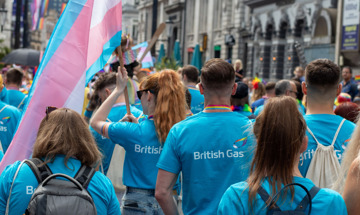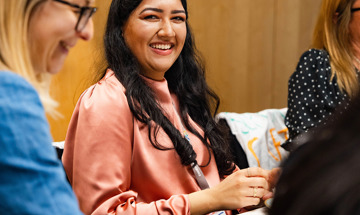Creating a more diverse and inclusive business
Recent events, from the global pandemic, police brutality in the US, anti-racism campaigns, to the tragic passing of Sarah Everard, have shone a spotlight on the systemic inequalities that persist across society.
At Centrica, we know that trusted and successful businesses represent the communities they serve, and get the best from their people by recognising diverse perspectives and respecting and valuing differences.
But we also know that good intentions don’t always lead to tangible outcomes. So we’re making sure we take meaningful action to create lasting change and build a more equal, diverse and inclusive workplace.

Hardwiring inclusivity
At the root of this is developing a culture that hardwires inclusivity into everything the company does.
“As an organisation, you should reflect the society in which you operate,” says Raj Roy, Group General Counsel and Company Secretary at Centrica, who leads many of our Diversity & Inclusion initiatives as the co-sponsor of VOICE, Centrica’s ethnicity network.
“In the past, we probably haven’t always challenged the status quo. But we’ve naturally evolved as a company and now there’s a real appetite to say, ‘No, as a business, we have to change to succeed and grow’.”
In terms of diversity and inclusion, this must go beyond just recruiting a more diverse workforce. Creating a genuinely inclusive environment in which employees operate is equally critical. Raj adds, “It’s no good if you don’t unlock the benefit of having that diversity across your company.”
Here are three ways we’re working to make Centrica a more diverse and inclusive place to work:
1. We will listen and act
“Speaking to our employee networks has confirmed the need to do more,” says Centrica Group CEO Chris O’Shea.
“Asking for their help to change our culture has been both sobering and inspiring: sobering in the sense that the pace of change has been so slow, and inspiring because we have such vibrant networks of wonderful colleagues desperate to make a difference.”
Initiatives include setting up a ‘shadow board’ of colleagues who will be empowered to positively disrupt executive thinking and decision making, which includes finding solutions to inclusion issues. Quarterly listening sessions and reverse mentoring are also key enablers to empower colleagues to help shape our culture and inclusion efforts.
The reverse mentoring programme, trialled in Raj’’s team and then rolled out company-wide, has already led to a “significant uplift” in employee engagement – and is showing leaders how they can learn to be better, provided that they are willing to be open, vulnerable and have a mindset of enquiry, says Raj.
He adds: “It works by pairing a member of our leadership team with someone who is simply willing to say, ‘What could I share with you that might help you, as a leader, to create the right kind of environment in which people from all sorts of backgrounds can be themselves and flourish?’”
2. We will set clear and ambitious targets and measure our progress
We’re committed to creating a workforce that truly represents the communities we serve, which is why we’ve set targets to drive greater representation for female, ethnic minority, disability, LGBTQ+ and ex-service personnel via our People & Planet Plan.
In particular, we’re acutely aware we must improve our gender diversity and want to achieve gender parity by 2030. This will be challenging for us, especially in engineering, where women currently make up just 9% of the team.
But we feel that aiming high is the right approach to deliver the change we all want and need, and towards this we’ve just announced that we’ll recruit 1,000 apprentices by 2022 with the ambition for 50% to be women.
Of the apprenticeship offers we have made so far in 2021, 50% were to women.
To help boost interest from women applicants, we have launched a targeted recruitment campaign that includes virtual careers events and engaging with women seeking a career change due to COVID-19. We’ve already seen a significant increase in the number of applications from women.
We have also signed up to the Tech She Can Charter, a commitment by organisations to increase women working in technology roles.
Speaking to our employee networks has confirmed the need to do more. Asking for their help to change our culture has been both sobering and inspiring
Chris O'Shea, Chief Executive
3. We will ensure everyone has equal access to opportunities
Embedding an inclusive approach to recruitment is key to “meeting and beating targets”, and building a workplace where everyone can succeed and deliver for our customers.
Raj says: “I had a conversation once with one of our colleagues who essentially said to me, ‘Your job descriptions are written for nuclear physicists - I read them as a working parent from an ethnic background, and I just want to exclude myself from that process’.”
Conversations like this are driving systemic changes like including inclusive language in every job description and advert, mandatory diverse shortlists and interview panels for every role, as well as anonymous screening that removes identifying information like the candidate’s name for senior roles.
Centrica will continue to provide career development opportunities for underrepresented groups, through the 1,000 apprentices mentioned earlier and partnerships with Women’s Ahead 30% Club and Mission Include.
We want to help create stronger and more inclusive communities too, and through our partnership with TechSheCan, we will work with schools to grow a more inclusive talent pipeline. We’re also encouraging colleagues to share their skills and volunteer 100,000 days towards this by 2030.

Case Study
Moving for mental health: Centrica on The Road to Paris
Our people

Case Study
20 years of the Carers Network
Our people

Case Study
#UnderTheScope for LGBTQ+ History Month
Our people

Case Study
Exploring new paths - a day in the life of an apprentice
Our people

Blog
An inclusive workforce is one where you don't need to fit in.
Our people

Blog
Carers Network: Taking Action, Making Impact
Our people
